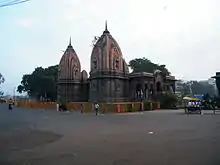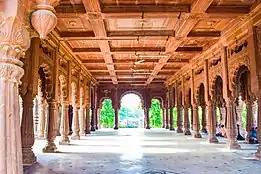Krishnapura Chhatri
The Krishnapura Chhatris, also known as the Krishna Pura Chhatris are three chhatris located in Indore, Madhya Pradesh, India.[1] The structures were built by the Holkars as cenotaphs over the spots where people of importance were cremated, leading to them also being known as the Holkar Chhatris. All three of the Chhatris are located half a kilometer from the city palace, Rajwada, which was also built by the Holkar dynasty.
 | |
| Location | Indore, Madhya Pradesh |
|---|---|
| Type | Chhatri |
| Material | Stone |
| Completion date | c. 1849 |
| Dedicated to | Holkar Dynasty |
Description
History
The powerful family that built the chhatris, the Holkars, were originally a minor clan within the Maratha empire. They belonged to the Dhangar caste, which originated in Maharashtra. While part of the Maratha empire, the Holkars fought against the Mughals and the British East India Company.[2] However, following the Third Anglo-Maratha War and the subsequent collapse of the Maratha empire in 1818, the Holkars agreed to establish a protectorate on behalf of the East India Company in Indore.[3] This diplomatic move established the Holkar dynasty, which ruled the Indore state until Indian Independence in 1948.[2][4]
The Krishnapura Chhatri themselves were built in the mid 19th century to honor the deceased members of the Holkar dynasty.[3][5] They are named for Krishna Bai Holkar, the wife of famed military leader Yashwantrao Holkar and the mother of Malhar Rao Holkar II. The structures are built over the spots where the rulers of the Indore state were cremated.[6][7]
Complex

The complex contains three chhatris and five cenotaphs. Steps from the back of the site lead to the bank of the nearby Kahn river. The chhatris are made of several different types of stone, and feature elaborately carved exteriors and columns.[5] The site around half a kilometer from Rajwada Palace.[8]
Due to the site's location within the city of Indore, parts of the complex have previously fallen into disrepair.[7][9] As of 2018 efforts were being conducted to clean up the area.[9][5] In 2018 the Madhya Pradesh Tourism Board announced that it would include the chhatris on a walking tour of the historic sites of Indore.[10]
References
- "Krishnapura Chhatris, Indore Cenotaphs, Krishnapura Chhatris Indore, Holkar Chhatris Indore, Indore Tourism, Indore Monuments, Tourist Attractions, Madhya Pradesh Tourism, MPTourism, Central India Heritage Tourism, Wildlife Tour Packages". madhya-pradesh-tourism.com. Retrieved 1 November 2018.
- Eaton, Richard M. (17 November 2005). A Social History of the Deccan, 1300-1761: Eight Indian Lives. Cambridge University Press. ISBN 9780521254847.
- Bharne, Vinayak; Krusche, Krupali (18 September 2014). Rediscovering the Hindu Temple: The Sacred Architecture and Urbanism of India. Cambridge Scholars Publishing. ISBN 9781443867344.
- Hoiberg, Dale; Ramchandani, Indu (2000). Students' Britannica India: I to M (Iblis to Mira Bai). Encyclopaedia Britannica (India).
holkar maratha clan.
- "5 Interesting facts about Krishnapura Chhatris of Indore - IndoreHD". IndoreHD. 9 January 2016. Archived from the original on 1 December 2017. Retrieved 1 November 2018.
- www.indore-tourism.com. "Krishnapura Chhatris, Chhatribagh Indore, Indore Chhatris, Chhatris in Indore, Krishnapura Chhatris Indore". indore-tourism.com. Retrieved 1 November 2018.
- "Krishnapura Chhatris cry for upkeep - Times of India". The Times of India. Retrieved 1 November 2018.
- "Shah starts mass contact in M.P." The Hindu. Press Trust of India. 7 October 2018. ISSN 0971-751X. Retrieved 1 November 2018.
- "Indore's historic Krishnapura Chhatris fall prey to junkies, rodents". hindustantimes.com/. 24 August 2016. Retrieved 1 November 2018.
- "Walk down Indore's legacy lanes for tryst with history - Times of India". The Times of India. Retrieved 1 November 2018.